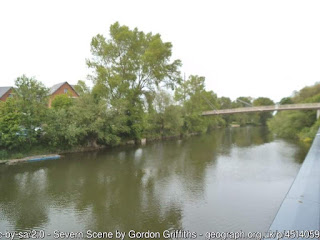Burrs Field Kingsland - The Story of Lead Manufacture in Shrewsbury.
This is the Story of Burr's Field Between Kingsland Bridge and Longden Coleham.
Shrewsbury was once an important lead manufacturing town.
Watch the story by viewing our video below, please do give us your comments and perspective upon the Burr's Field Lead Works.
The lead works were owned by the Burr family and were situated near the river Severn in Kingsland, to the left of the Kingsland Bridge.
Once a dirty fuming and noisy scene of industry it is now pleasant public parkland.
The story is that: The Burrs were a London-based family of plumbers.
Thomas Burr, moved to Shrewsbury in 1813, and started 80 years of lead manufacturing in Shrewsbury.
His family had patented an invention known as the ‘Burr’s Lead Squirting Press’.
Using this he was able to make lead pipes more cheaply than his competitors and his business prospered.
In 1829 he moved his business from within town, and notably built a shot tower, allowing him to add lead-shot for gun cartridges, to his products which included paint and cosmetics.
The shot-tower was 150ft high, 30ft in diameter at its base and 12ft in diameter at the top.
In the shot tower molten lead was passed through a copper sieve at the top of the tower, and the falling lead landed as lead-shot balls, in a water bath at the bottom.
Burr’s lead works were heavily criticised on account of the bad smelling smoke, soil, and water pollution they caused.
In modern times chemical analysis of the ground near the factory showed 780 grams of red lead per square foot.
The modern maximum for a safe blood lead level is far lower and less than one 10 millionth of a gram.
No wonder that the workers suffered from lead poisoning, and early deaths.
Even now, the factory site is too contaminated to be used for agriculture or housing.
Text: Based upon Dr Andrew Pattison's article at his excellent website shrewsburylocalhistory.org.uk
Note: All images are illustrative only for your entertainment, and do not necessarily represent the long demolished buildings in Burrs Field etc..
This is the Story of Burr's Field Between Kingsland Bridge and Longden Coleham.
Shrewsbury was once an important lead manufacturing town.
Watch the story by viewing our video below, please do give us your comments and perspective upon the Burr's Field Lead Works.
The lead works were owned by the Burr family and were situated near the river Severn in Kingsland, to the left of the Kingsland Bridge.
Once a dirty fuming and noisy scene of industry it is now pleasant public parkland.
 |
| Location of Burr's Field - Copyright Google Maps |
The story is that: The Burrs were a London-based family of plumbers.
Thomas Burr, moved to Shrewsbury in 1813, and started 80 years of lead manufacturing in Shrewsbury.
His family had patented an invention known as the ‘Burr’s Lead Squirting Press’.
Using this he was able to make lead pipes more cheaply than his competitors and his business prospered.
In 1829 he moved his business from within town, and notably built a shot tower, allowing him to add lead-shot for gun cartridges, to his products which included paint and cosmetics.
The shot-tower was 150ft high, 30ft in diameter at its base and 12ft in diameter at the top.
In the shot tower molten lead was passed through a copper sieve at the top of the tower, and the falling lead landed as lead-shot balls, in a water bath at the bottom.
Burr’s lead works were heavily criticised on account of the bad smelling smoke, soil, and water pollution they caused.
In modern times chemical analysis of the ground near the factory showed 780 grams of red lead per square foot.
The modern maximum for a safe blood lead level is far lower and less than one 10 millionth of a gram.
No wonder that the workers suffered from lead poisoning, and early deaths.
Even now, the factory site is too contaminated to be used for agriculture or housing.
Text: Based upon Dr Andrew Pattison's article at his excellent website shrewsburylocalhistory.org.uk
Note: All images are illustrative only for your entertainment, and do not necessarily represent the long demolished buildings in Burrs Field etc..



